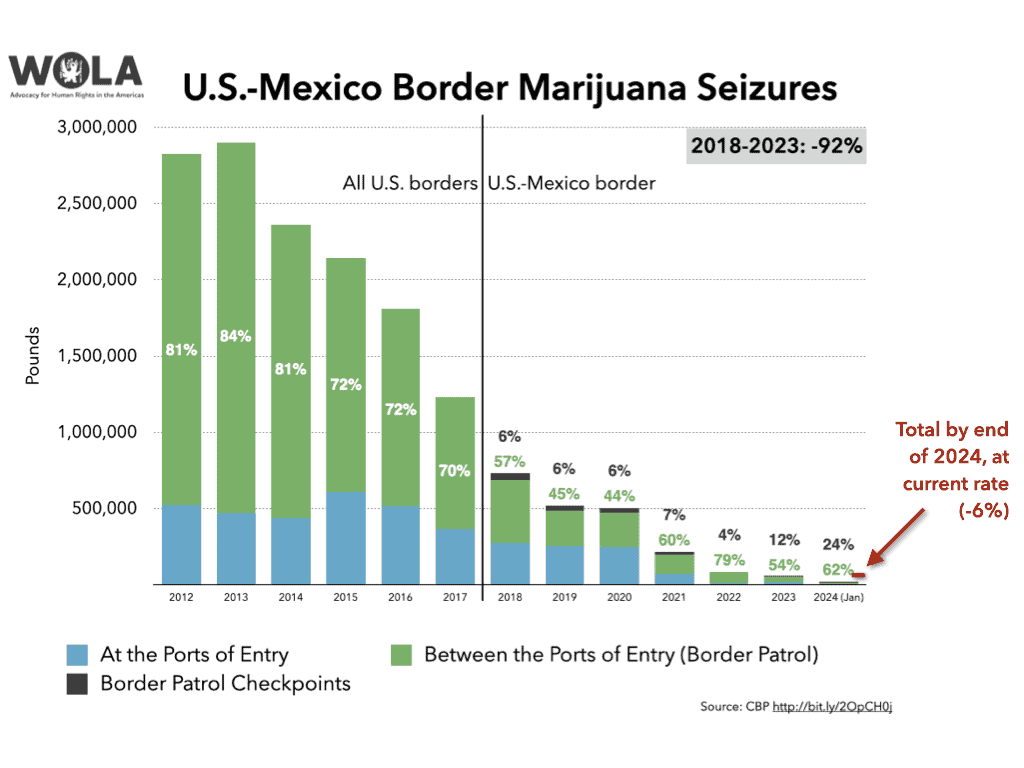With this series of weekly updates, WOLA seeks to cover the most important developments at the U.S.-Mexico border. See past weekly updates here.
Support ad-free, paywall-free Weekly Border Updates. Your donation to WOLA is crucial to sustain this effort. Please contribute now and support our work.
Leaked data points to a 13 percent increase in Border Patrol migrant apprehensions at the U.S.-Mexico border from January to February. Last month’s unofficial total is high for a typical February, but lower than most months during the past three years. The top two sectors for migrant arrivals were in Arizona and California. Mexico broke its single-month migrant apprehensions record in January, capturing nearly as many people that month as the U.S. Border Patrol did. Migration through Honduras illustrates many migrants’ use of a route that involves flights to Nicaragua.
Boats ferrying people to the beginning of the Darién Gap migration trail halted for five days at the end of February. The transport companies called a strike to protest the Colombian Navy’s seizure of two vessels. Ferries restarted after an agreement with the Colombian government, at a meeting that included the presence of a U.S. embassy official. The Darién route into Panama is growing more treacherous, as Doctors Without Borders is reporting an alarming increase in sexual assaults committed against migrants in the jungle so far this year.
As Democratic senators call on the Biden administration to increase funding for fentanyl interdiction at the border, CBP is reporting fewer seizures so far in fiscal year 2024. The agency is on pace to seize 25 percent less of the synthetic opioid than it did in 2023. This would be the first year-on-year decline after several years of very rapid growth. WOLA charts also depict a reduced pace of heroin and marijuana seizures, and an increased pace of cocaine and (less sharply) methamphetamine seizures.
As normally occurs in spring, migration is increasing again at the U.S.-Mexico border. The first three days of March saw Border Patrol migrant apprehensions reach 7,000 per day, dropping to 5,500 on March 4, reported CBS News and Border Report.
That is up from 4,000 per day in January and 4,850 per day in February. The latter estimate comes from unofficial U.S. Customs and Border Protection (CBP) data for February 2024, leaked to NewsNation reporter Ali Bradley, who published it to her Facebook account.
According to this data, Border Patrol may have apprehended 140,709 migrants between the border’s ports of entry in February, up from 124,220 in January. Both numbers are down sharply from 249,735 apprehensions in December 2023, which was a record.
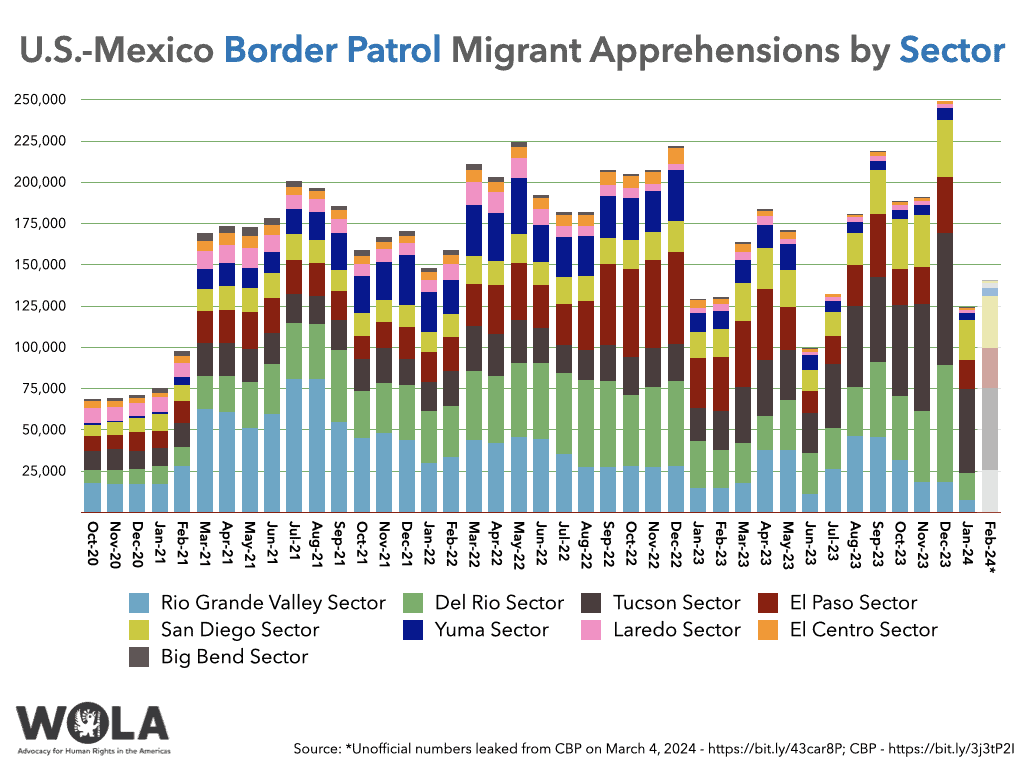
While February’s unofficial total is the seventh-fewest of the Biden administration’s thirty-seven full months in office, it is Border Patrol’s fourth-busiest February since 2000, according to available data. It is more than February 2023 but less than February 2022.
According to the leaked data, in February another 49,264 migrants, mostly people with CBP One appointments, entered CBP custody at land-border ports of entry.
Of Border Patrol’s unofficial February apprehensions, 60.2 percent were single adults, similar to January’s 62 percent. The rest were migrants arriving as parents with children or as unaccompanied children.
The Cato Institute’s David Bier reported that known successful evasions of Border Patrol, also known as “gotaways,” have declined—in the agency’s estimate—from 2,671 per day the week before the Title 42 policy ended last May to about 800 per day so far in fiscal year 2024.
Bradley’s post shared that, as in every month since July, agents in Border Patrol’s Tucson, Arizona sector apprehended the most migrants, of the nine sectors into which the agency divides the U.S.-Mexico border. For the second consecutive month, the agency’s San Diego, California sector was in second place. While Texas sectors are no longer in the lead, migration is rising again in El Paso and the Rio Grande Valley.
The preliminary data point to Tucson decreasing slightly from January to February, while San Diego continued to increase. Twitter updates from the Border Patrol sector’s chief in San Diego show week-to-week increases at the beginning of 2024, followed by a leveling off.
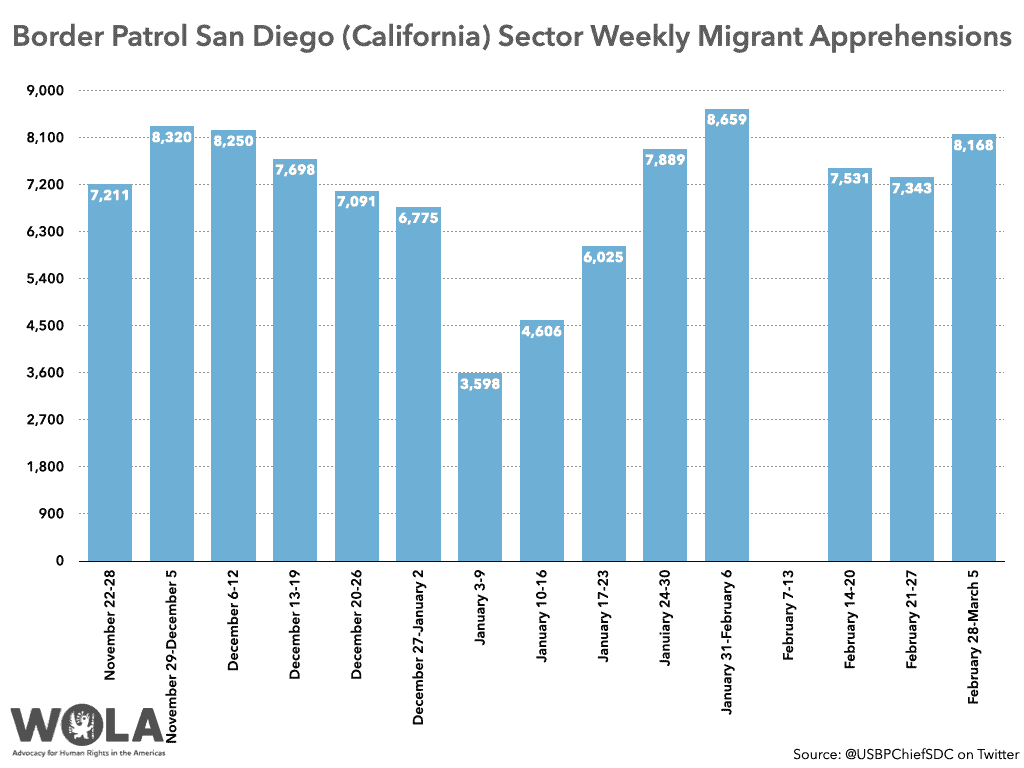
In California, asylum seekers hoping to turn themselves in to Border Patrol agents are now coming to Campo, California—about 50 miles east of San Diego, where the Pacific Crest Trail begins—instead of Jacumba Springs, the past few months’ principal destination in the central California border. According to Border Report, the geographic shift owes to Mexican security and migration forces stepping up patrols across from Jacumba Springs.
This is part of an overall jump in Mexico’s migration enforcement in January, likely a response to a post-Christmas visit to Mexico City from the U.S. Secretaries of State and Homeland Security. Data released in late February show that Mexico apprehended 119,469 migrants in January, smashing its prior record of 97,969 set in November 2023. Mexico’s apprehensions were nearly as many as the U.S. Border Patrol’s, which were less than 5,000 greater.

Migrants whom Mexico apprehended in January came from 110 countries; 15 percent of them were citizens of nations in Asia (6 percent) or Africa (9 percent). Venezuela, the number-one nationality among Mexico’s migrant apprehensions since March 2023, accounted for 19 percent of the total.

Tougher Mexican government operations have left about 800 migrants stranded in a tent encampment along the Suchiate River, at Mexico’s border with Guatemala near Tapachula, according to a statement from local human rights defenders. “People are being forced to wait up to seven days to get answers from the INM [Mexico’s migration agency] and be transferred to Tapachula or Tuxtla Gutierrez,” the capital of Mexico’s southernmost state of Chiapas. “During this time, they do not receive any type of assistance.”
During February, 8,368 people applied for asylum in Mexico’s system, reported Mexico’s Refugee Assistance Commission (COMAR). That is fewer than in February 2022 (10,192) and February 2023 (11,321).
During the first two months of the year, COMAR is behind its 2023 pace but about the same as 2022, when it ended the year with 119,225 asylum applications. (They totaled a record 140,948 in 2023.) So far this year, at least 1,000 migrants have sought asylum in Mexico from Honduras, Cuba, Haiti, and El Salvador.

In Honduras, where the government publishes updates of migration data quickly, the number of migrants registering as they transit the country (a strong majority all migrants) increased in February to 49,357 from 38,495 in January. The total still remains below migration levels measured in July-November 2023.

More than half of February’s migrants transiting Honduras (52 percent) were citizens of Venezuela, nearly all of whom had transited the Darién Gap. Three non-Western Hemisphere nationalities—Guinea, China, and Mauritania—were among the top ten in February. For unclear reasons, registered migration through Honduras of citizens of Senegal dropped from 1,214 in January to 22 in February.
Senegal, the Associated Press reported, is among African nations whose citizens are opting to migrate via an air route through Nicaragua, which allows them to elide the treacherous Darién Gap en route to the U.S.-Mexico border. In Dakar, social media has made it widely known that travel to Nicaragua, which does not require visas for those visiting by air, is a possibility. Smugglers charge about $10,000 for the trip.
U.S. border authorities encountered migrants from Senegal 20,231 times between July and December 2023, according to the AP. (Senegal is one of many nationalities that Customs and Border Protection does not specify in its monthly reporting, lumping it in an ever-expanding “Other Countries” category.)
The New York Times reported on February 29 from the airport in Bogotá, Colombia, where an increasing number of migrants, many from Africa, change planes en route to Nicaragua.
Panama’s government has yet to publish February data about migration through the Darién Gap, which totaled 36,001 people in January—up from 24,626 in December but the 3rd-lowest monthly amount of the last 12. This dangerous jungle route straddling Panama and Colombia, however, has experienced more turmoil than usual since late February.
The Darién Gap saw a pause in migration during the last five days of February. During the week of February 19, Colombia’s navy had seized two of the boats that ferry migrants across the Gulf of Urabá to Acandí, Colombia, where the jungle route begins. In protest, boat operators carried out a “strike,” ceasing operations and causing the beachside towns of Necoclí and Turbo, migrants’ departure point, to fill up with about 5,000 stranded people from many countries. The boat companies’ protest was first reported by the New York Times.
The strike ended, and the flow of people resumed, on March 1. The resumption followed a meeting between boat operators, Colombian local and national government officials, and a representative of the U.S. embassy in Colombia. They agreed that from now on, migrants aboard the boats must register on a mobile phone app.
By March 4, the Associated Press reported, 3,000 of the stranded people had since departed Necoclí.
At the other end of the Darién route in Panama, for unrelated reasons, about 250 migrants staged a disturbance at the San Vicente Temporary Migratory Reception Station on the night of March 1. Acts of vandalism damaged or destroyed about 10 modular buildings. Panama plans to prosecute 44 people.
Passage through the Darién jungles is more treacherous than ever. Doctors without Borders, which maintains health posts in reception centers where the trail ends in Panama, reported treating 233 victims of sexual violence in January and February alone; the organization reported 676 cases in all of 2023.
The trend is accelerating: Doctors Without Borders reported in January that more than half of 2023 assaults happened in the last quarter of the year. “In the latest assaults, the level of brutality is extreme. A dozen armed men are holding more and more migrant groups of between 100 and 400 people.”
On March 7 Doctors Without Borders reported a stunning development: the government of Panama suspended its activities in the Darién region. The ostensible reason for the suspension is the lack of “a collaboration agreement in force” with Panama’s Ministry of Health. MSF stated that it “has been trying in vain to obtain such a renewal since October 2023.”
A letter from 17 Democratic senators called on President Biden to include “robust funding for border security and drug interdiction efforts to stem the flow of fentanyl and similar illicit drugs” in the 2025 budget request that the White House will send to Congress on Monday, March 11.
Meanwhile, NBC News reported that, lacking congressionally appropriated funds, Customs and Border Protection (CBP) has been unable to install already-purchased scanners at border ports of entry that would be able to detect more smuggled fentanyl. The agency needs “approximately $300 million [to] actually put the technology in the ground,” said Acting Commissioner Troy Miller.
Using statistics through January 2024 from CBP’s dataset, WOLA presents a series of charts showing trends in the agency’s U.S.-Mexico border seizures of fentanyl and four other drugs.
Four months into the 2024 fiscal year, CBP’s border-zone seizures of fentanyl are on pace to total 20,061 pounds by the end of the year. That would be a reduction of 25 percent from 2023. As in recent years, the vast majority (92 percent) is seized at land-border ports of entry or interior vehicle checkpoints.
It is not clear why the fentanyl seizure number is trending down after several years of stratospheric growth. Media reports indicate that Mexico’s Sinaloa Cartel ordered its members to cease producing and transshipping the drug, which if true could be disrupting the market.
The flow of fentanyl is a very western phenomenon: California and Arizona ports of entry encompass 94 percent of January’s seizures, with another 3 percent carried out by San Diego Border Patrol agents. Within those two states, the center of gravity shifted from California to Arizona in late 2022 and remains that way.

Fentanyl’s rapid spread has decimated the market for the principal illicit plant-based opioid, heroin. CBP’s border-zone heroin seizures are on pace to total 765 pounds by the end of the year, a 38 percent drop from 2023 and just 15 percent of what they were in 2021. As in recent years, the vast majority of heroin (91 percent) is seized at land-border ports of entry or interior vehicle checkpoints.
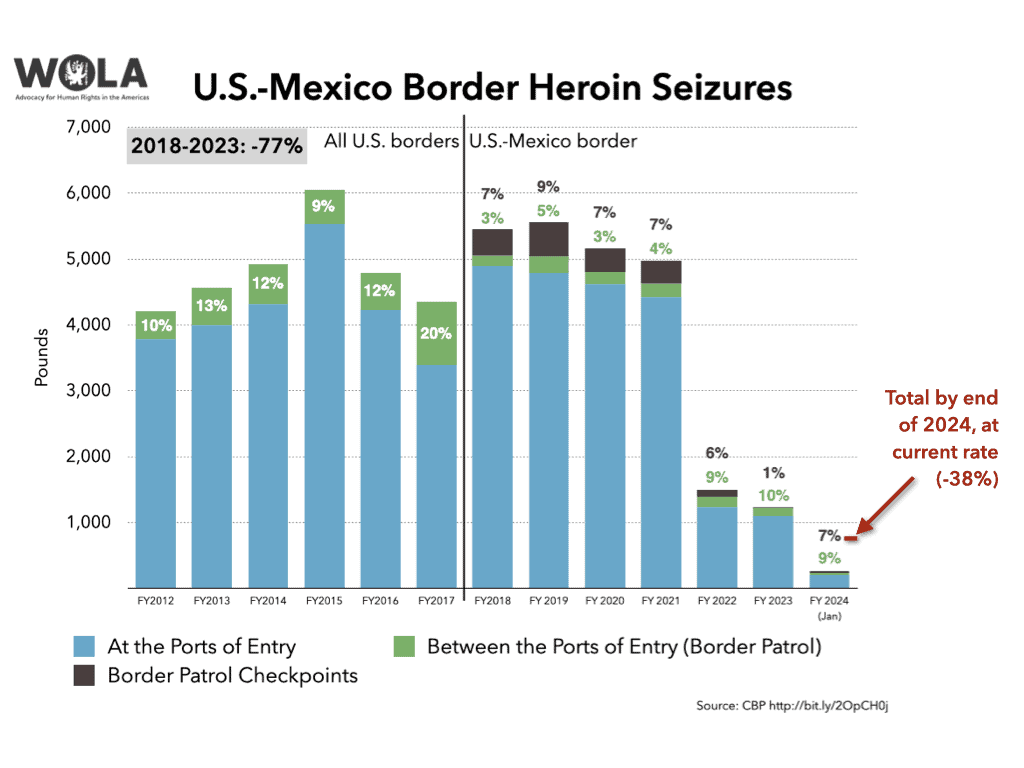
CBP’s border-zone cocaine seizures are on pace to total 37,149 pounds by the end of the year, which would exceed 2023 by 35 percent. This would be the first significant jump in cocaine seizures at the border after years of elevated production in the Andes, most of which had most likely gone to non-U.S. markets. As in recent years, the vast majority (92 percent) of cocaine seizures take place at land-border ports of entry or interior vehicle checkpoints.
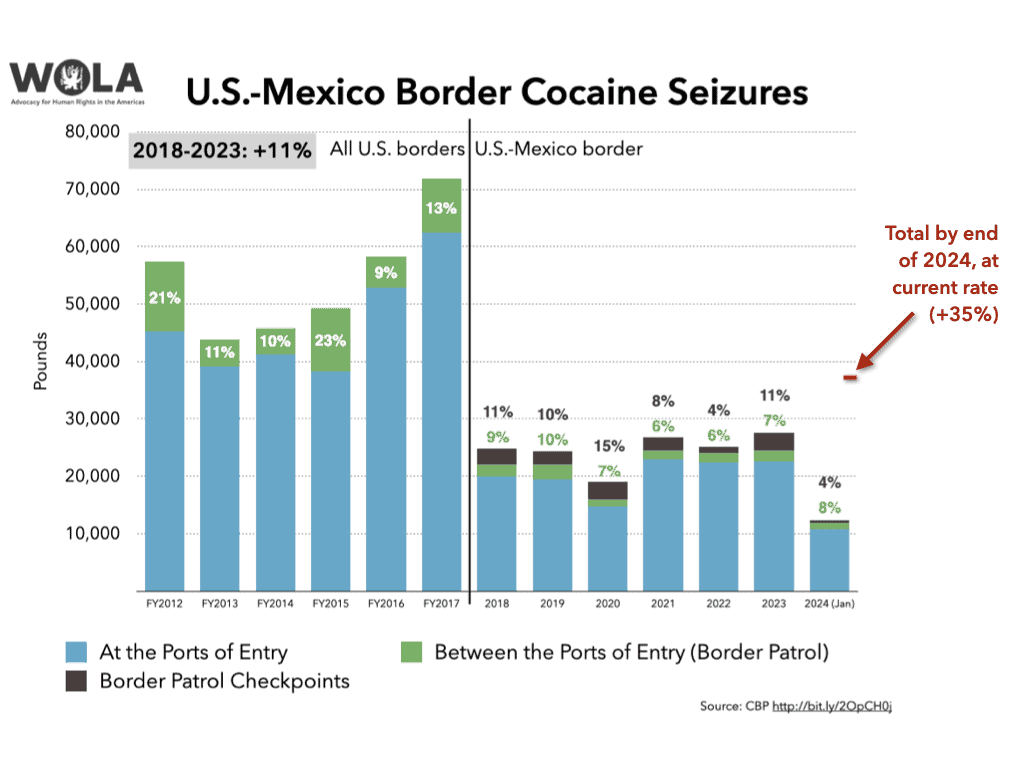
CBP’s border-zone methamphetamine seizures are on pace to total 132,045 pounds by the end of the year, up slightly—9 percent—from 2023. As in recent years, the vast majority (96 percent) is seized at land-border ports of entry or interior vehicle checkpoints. Meth seizures have declined from a high in 2021; it is not clear why, or whether, the pandemic played a role in a sharp 2020-21 increase.
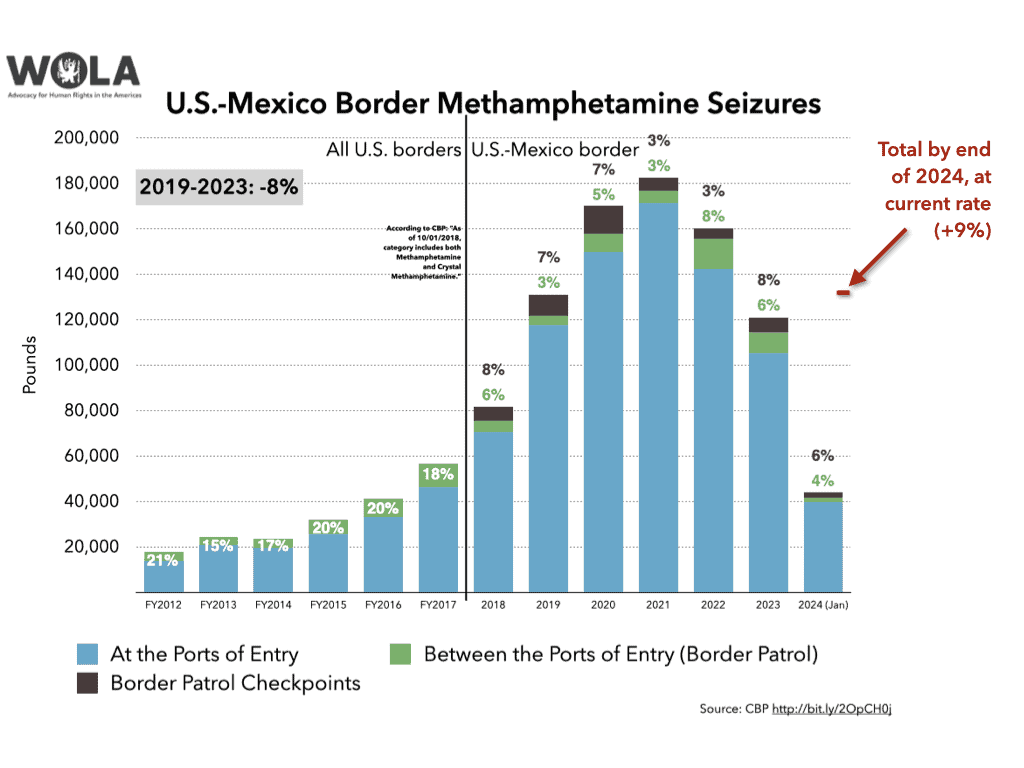
Marijuana seizures continue a years-long decline. If the pace set during the first four months of fiscal 2024 continues, this year’s seizures would total 57,660 pounds, about 8 percent of what they were in 2018.
The cause is the legalization of cannabis in many U.S. states, which has created a regulated domestic industry and curtailed incentives to risk smuggling the drug from Mexico. Of what is seized, marijuana continues to be the only drug that is principally seized by Border Patrol between ports of entry—62 percent of total seizures so far this year.
